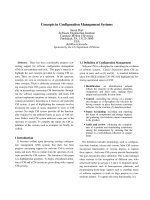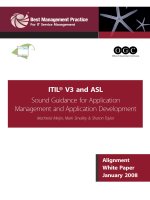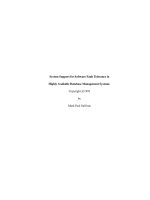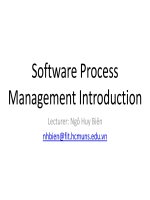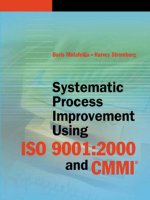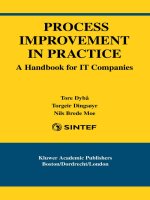Software Process Improvement Journey: IBM Australia Application Management Services ppt
Bạn đang xem bản rút gọn của tài liệu. Xem và tải ngay bản đầy đủ của tài liệu tại đây (1.09 MB, 90 trang )
Software Process
Improvement Journey:
IBM Australia Application
Management Services
Robyn Nichols
Colin Connaughton
March 2005
TECHNICAL REPORT
CMU/SEI-2005-TR-002
ESC-TR-2005-002
A Report from the
Winner of the 2004
Software Process
Achievement Award
Pittsburgh, PA 15213-3890
Software Process
Improvement Journey:
IBM Australia Application
Management Services
A Report from the
Winner of the 2004
Software Process
Achievement Award
CMU/SEI-2005-TR-002
ESC-TR-2005-002
Robyn Nichols
Colin Connaughton
March 2005
IBM Australia Application Management Services
Unlimited distribution subject to the copyright.
The Software Engineering Institute is a federally funded research and development center sponsored by the U.S. Depart-
ment of Defense.
Copyright 2005 Carnegie Mellon University.
NO WARRANTY
THIS CARNEGIE MELLON UNIVERSITY AND SOFTWARE ENGINEERING INSTITUTE MATERIAL IS
FURNISHED ON AN “AS-IS” BASIS. CARNEGIE MELLON UNIVERSITY MAKES NO WARRANTIES OF ANY
KIND, EITHER EXPRESSED OR IMPLIED, AS TO ANY MATTER INCLUDING, BUT NOT LIMITED TO,
WARRANTY OF FITNESS FOR PURPOSE OR MERCHANTABILITY, EXCLUSIVITY, OR RESULTS OBTAINED
FROM USE OF THE MATERIAL. CARNEGIE MELLON UNIVERSITY DOES NOT MAKE ANY WARRANTY OF
ANY KIND WITH RESPECT TO FREEDOM FROM PATENT, TRADEMARK, OR COPYRIGHT INFRINGEMENT.
Use of any trademarks in this report is not intended in any way to infringe on the rights of the trademark holder.
Internal use. Permission to reproduce this document and to prepare derivative works from this document for internal use is
granted, provided the copyright and “No Warranty” statements are included with all reproductions and derivative works.
External use. Requests for permission to reproduce this document or prepare derivative works of this document for external
and commercial use should be addressed to the SEI Licensing Agent.
This work was created in the performance of Federal Government Contract Number F19628-00-C-0003 with Carnegie Mel-
lon University for the operation of the Software Engineering Institute, a federally funded research and development center.
The Government of the United States has a royalty-free government-purpose license to use, duplicate, or disclose the work,
in whole or in part and in any manner, and to have or permit others to do so, for government purposes pursuant to the copy-
right license under the clause at 252.227-7013.
For information about purchasing paper copies of SEI reports, please visit the publications portion of our Web site
(
CMU/SEI-2005-TR-002 i
Table of Contents
Foreword v
Acknowledgments vii
Abstract ix
1 Introduction 1
2 The AMS Australia Process Improvement Journey 3
2.1 The Early Process Improvement Steps 4
2.2 SW-CMM Maturity Level 2 4
2.2.1 Approach to Gap Analysis and Planning 5
2.2.2 The Initial Transformation Framework 1997-1999 7
2.3 SW-CMM Maturity Level 3 8
2.3.1 The Transformation Framework for SW-CMM Maturity Level 3 9
2.4 CMMI-SE/SW Maturity Level 5 10
2.4.1 The Transformation Framework for CMMI-SE/SW Maturity
Level 5 12
3 The Benefits 15
3.1 Performance 15
3.1.1 Charting the Results of Process Improvement 16
3.2 People 19
3.2.1 Background 19
3.2.2 Client and Staff Satisfaction 20
3.2.3 Benefits for All Employees: Observations 20
4 Lessons and Observations 23
4.1 The Initial Drivers for Process Improvement 23
4.1.1 Why CMM? 24
4.1.2 SW-CMM to CMMI-SE/SW 25
4.2 Process Improvement as an Organizational Transformation Program 26
4.2.1 Organizational Change Management 26
4.2.2 Sponsorship of Process Improvement Programs 29
4.2.3 Culture of the Large Organization and Process Improvement 31
ii CMU/SEI-2005-TR-002
4.2.4 Piloting 32
5 Organizational Assets and Supporting Infrastructure 35
5.1 Processes, Methods, and Tools 35
5.1.1 The AMS Management System 35
5.1.2 IBM Global Services Method 39
5.1.3 Tools and Technology 39
5.1.4 Rational Tools 40
5.1.5 Knowledge Management 41
5.2 Organization and People 42
5.2.1 People CMM
®
in IBM 42
5.2.2 Managing and Training People 44
5.2.3 Organizational Structure 45
5.2.4 Organizational Meetings—P3 46
5.2.5 Process Improvement Team 48
5.2.6 The Software Engineering Process Group 49
5.2.7 Process and Product Quality in IBM 51
5.2.8 Involvement of Practitioners in Process Development 55
6 Measurement and Metrics 57
6.1 Selection of Key Metrics for the Organization 58
6.2 Managing the Projects Using Metrics 60
6.3 Statistical Process Control Approach 61
6.4 Measurement and Reporting Infrastructure 63
6.5 Performance Models 65
6.6 Using Metrics to Improve the Future 68
7 AMS Australia Today and Tomorrow 69
Appendix Acronyms 71
References 73
CMU/SEI-2005-TR-002 iii
List of Figures
Figure 1: A Timeline of Major Points in the AMS Process Improvement Journey 3
Figure 2: AMS Australia Basic Organizational Structure 5
Figure 3: ADE Hexagon and Key Areas 6
Figure 4: The ADE Approach to Change 6
Figure 5: On-Time Delivery 16
Figure 6: On-Budget Delivery 17
Figure 7: Customer Satisfaction 17
Figure 8: Account Productivity (FP/FTE) 18
Figure 9: Monthly Problem Resolution 18
Figure 10: Problems per 1,000 FPs Maintained and Severity 1 Problems per 1,000
FPs Maintained 19
Figure 11: The AMS Management System Conceptual Procedure Map 38
Figure 12: AMS Management System Procedure List 38
Figure 13: Knowledge Management Tools 42
Figure 14: Process, People, and Performance Meetings (P3)—Critical Thread
Reviews (CTRs) 47
Figure 15: SEPG Structure 50
Figure 16: The Three Major Quality Management Processes 51
Figure 17: Process Adherence Verification—CMMI View 54
iv CMU/SEI-2005-TR-002
Figure 18: OFI Action Process 56
Figure 19: Identification of Key Metrics 59
Figure 20: Key Metrics Table Entry 60
Figure 21: Measurement Collection and Reporting Tools 61
Figure 22: Control Chart for Project Delivery (On-Time) 62
Figure 23: Measurement and Reporting Infrastructure 64
Figure 24: AMS Measurements Web Site 65
Figure 25: Application Delivery Center Reporting 66
Figure 26: Defect Rate Matrix Report 67
Figure 27: Comparison of Phase-Injected Ratios 67
CMU/SEI-2005-TR-002 v
Foreword
Software Process Achievement (SPA) Awards are given to recognize outstanding achieve-
ments in improving an organization's ability to develop and maintain software-intensive sys-
tems. In addition to highlighting and rewarding excellence, the Award co-sponsors—the Insti-
tute of Electrical and Electronics Engineers (IEEE) Computer Society and the Software
Engineering Institute (SEI)—intend to foster continuous advancement in the practice of both
process improvement and software engineering through the dissemination of insights, experi-
ence, and proven practices throughout the relevant research and practitioner communities. In
May 2004, the SPA Award Committee selected IBM Global Services Application Manage-
ment Services (AMS) Australia for a 2004 SPA Award in recognition of rapid, continuous,
improvement to
their software capability in response to increasingly stringent marketplace
demands.
With respect to the Award’s criteria, the Committee’s rationale for this decision was as fol-
lows:
Significant: The improvements must have a demonstrated impact on the organization’s
software capability.
Over the past eight years, AMS Australia has achieved high levels of software capability
across a wide variety of software projects. Productivity, quality, and client satisfaction
measures have significantly, and steadily, improved as a result of their well-planned and
well-executed improvement program. Their improvements were guided by the Capability
Maturity Model
®
for Software (SW-CMM
) framework [Paulk 93a, Paulk 93b]. In their
most major projects, they were able to actually move directly from level 3 to level 5, an
unusual and truly significant achievement. AMS Australia accomplished this improve-
ment in the face of quite demanding year-to-year increases to the requirements for pro-
ductivity and quality improvements levied by their clients.
Sustained: The improvements must have resulted in a broad, documented improvement
program that will have a positive impact on the organization’s future projects.
A particularly impressive part of AMS Australia’s accomplishments is the degree to
which they have established a strong commitment to continuous improvement at all lev-
els of their organization. Top executives are fully committed to continued support for the
improvement activities. And project personnel are universally and routinely informed of
not only the importance of continuous software capability improvement but also effective
Capability Maturity Model and CMM are registered in the U.S. Patent and Trademark Office by
Carnegie Mellon University.
vi CMU/SEI-2005-TR-002
practices to support and ensure continuous improvement. Operationally, AMS Australia
has developed a wide variety of templates, examples, measurement data, training materi-
als, and well-defined infrastructure technology. These process improvement assets not
only “encode” their improvement program but are also readily available throughout the
organization.
Measured: The improvements must be supported by data clearly demonstrating im-
proved software capability to date as well as a plan to use data to guide future improve-
ments.
Another particularly impressive part of AMS Australia’s accomplishments is the ex-
tremely broad and well-defined set of metrics they have established to assess status and
guide continuous improvement. The organization, unlike others that the Committee has
reviewed, focused on measurement at the very beginning of their improvement activities.
This, in fact, was the reason they were able to move directly from level 3 to level 5.
Level 4 of the CMM counsels implementation of data collection and use of the data for
statistical management control. AMS Australia had essentially implemented this im-
provement step at the very beginning of its improvement activities.
Impacting: The improvements must be shared throughout the organization, as well as
with the community at large, to amplify their impact.
AMS Australia’s initial improvement efforts focused on a large, major project that consti-
tuted almost all of their business. As their business has grown, new projects have been
quickly “brought up to date” by using prior experiences to start them off at high levels of
capability. Recently, AMS Australia has started to share their process improvement ex-
periences and capability with other parts of IBM Global Services. That, along with this
publication of their experiences and capability as a SPA awardee, will help other organi-
zations in the community at large.
William E. Riddle,
Chairman, SPA Award Committee
CMU/SEI-2005-TR-002 vii
Acknowledgments
This report recognizes the staff of AMS Australia and acknowledges their effort and com-
mitment in making our vision for process improvement real. In particular the effort of those
who led and motivated the organization in the improvement program made an essential con-
tribution.
Thank you to those who have contributed material to this report, in particular Alan Norton,
who was a key part of the AMS Australia process improvement program.
viii CMU/SEI-2005-TR-002
CMU/SEI-2005-TR-002 ix
Abstract
IBM Global Services Application Management Services (AMS) Australia provides applica-
tion development and support services, on an outsourcing basis, to a variety of clients. Typi-
cally, the organization delivers more than 3,000 work products in a year, with over 1,000 pro-
jects completed within overall schedule, budget, and productivity commitments. Client
expectations of service standards increase year by year, requiring corresponding improve-
ments in service delivery capability.
In July 1997, IBM Australia began providing application management services to a major
client. Services were initially provided by over 2,500 staff members in 17 locations, servicing
over 370 applications accessed by more than 55,000 users. Over the next six years, the ser-
vice delivery teams were transformed into an organization whose practices have now been
formally assessed at Capability Maturity Model
®
Integration (CMMI
®
) for Systems Engineer-
ing and Software Engineering, Version 1.1 (CMMI-SE/SW, V 1.1) maturity level 5.
Significant improvements to software practices led to improvements in cost, on-time delivery,
on-budget delivery, and client satisfaction achievements. Over the same period, an applica-
tion development productivity improvement of 76 percent delivered cost savings of A$412
million.
In May 2004, the Software Process Achievement Award Committee selected AMS Australia
to receive a Software Process Achievement Award in recognition of those achievements. This
report describes the history and experiences of the process improvement initiatives that trans-
formed the AMS Australia organization.
x CMU/SEI-2005-TR-002
CMU/SEI-2005-TR-002 1
1 Introduction
The benefit our organization has received by having a process improvement focus is
unquestionable—in terms of productivity, quality, and customer satisfaction. Al-
though the journey has been at times difficult, it has strengthened the team and in-
stilled a sense of pride in performance. Our focus on process and quality is now insti-
tutionalized throughout the organization, providing a strong foundation for our
further evolution. Our journey continues.…
- David Norris, General Manager, AMS Australia
In July 1997, IBM Australia began providing application management services to a major
client with 17 locations up to 1,500 kilometers apart and with over 370 applications being
accessed by more than 55,000 users.
Originally, those services were delivered by over 2,500 staff members operating in disparate
project groups and working in a Capability Maturity Model for Software (SW-CMM) level 1
environment. Over the next six years, this structure was transformed into IBM Global Ser-
vices Applications Management Services (AMS) Australia, an organization whose work prac-
tices have now been formally assessed at Capability Maturity Model Integration (CMMI
)
for Systems Engineering and Software Engineering, Version 1.1 (CMMI-SE/SW, V1.1) ma-
turity level 5 [CMMI 02].
During that six-year period, the AMS Australia service delivery team’s software practices
underwent significant evolution, resulting in key improvements in
• cost reduction
• on-time delivery (98.5 percent of deliverables on time—an improvement of 9.6 percent)
• on-budget delivery (99.6 percent of projects on budget—an improvement of 41.3 per-
cent)
• client satisfaction (currently 88.4 percent as reported in project completion surveys—an
improvement of 33 percent in the last five years)
• problem resolution (The number of problems reported in production fell by 53 percent in
the 1998-2002 period, and 98.4 percent are now closed within the client-specified time
scale.)
Of particular note is a 76 percent application development productivity improvement, which
has delivered cumulative cost savings of approximately A$412 million to the client over the
CMMI is registered in the U.S. Patent and Trademark Office by Carnegie Mellon University.
2 CMU/SEI-2005-TR-002
past five years (compared with the price that would have been paid for the same portfolio of
work by the client in the same period).
When compared to the estimated cost of process improvement initiatives, these savings rep-
resent a return on investment (ROI) approaching 10 times.
Today, AMS Australia is made up of approximately 2,000 information technology (IT) pro-
fessionals located in seven capital and regional cities across multiple site locations in five
Australian states, serving multiple clients.
During the course of a single year, AMS Australia typically delivers more than 3,000 work
products (client deliverables), with over 1,000 projects being delivered to a standard that
meets their overall schedule, budget, productivity, and quality commitments.
AMS Australia has numerous strategic goals, which include a focus on the continual im-
provement of the AMS Australia delivery capability to meet the demands of current clients
and the marketplace. While a range of improvement initiatives in areas such as organizational
structure, development methods, and tools have been undertaken, the primary improvement
mechanism has been the establishment of standard development and management processes.
These processes, which are documented in the AMS Australia Management System, describe
the practices required of AMS Australia staff; a managed program of improvements to the
processes is used to enhance the AMS Australia service delivery capability.
AMS Australia is a part of the IBM Global Services team in Australia and IBM Global Ser-
vices worldwide team. The IBM Global Services AMS worldwide team consists of approxi-
mately 36,000 employees around the globe in 30 countries.
Many areas of IBM Global Services worldwide have individually been appraised against the
SW-CMM, in addition to other models. IBM is committed to a continual program of im-
provement to ensure that all teams are enabled to deliver high-quality products and services.
IBM is also committed to delivering a service of the highest possible quality to its clients,
making sure their experience with IBM is superior in every way possible.
The journey of process improvement described in this report is for AMS Australia. That jour-
ney reflects the pervasive culture of IBM worldwide to deliver quality products and services
to its clients.
CMU/SEI-2005-TR-002 3
2 The AMS Australia Process Improvement
Journey
The AMS Australia process improvement journey has taken place over several years, cover-
ing multiple initiatives and the involvement of many people, each committed to the goal of
establishing AMS Australia as a highly regarded and professional application management
services delivery organization.
Even though that goal has been reached, AMS Australia recognizes that the journey is far
from over. In fact, there is the realization that, by using its collective data and knowledge,
AMS Australia can achieve even more to further expand and improve its capability, ulti-
mately delivering greater value to its clients in an increasingly competitive and complex
marketplace.
The timeline shown in Figure 1 and the following bullet points highlight major points in the
AMS Australia process improvement journey.
Figure 1: A Timeline of Major Points in the AMS Process Improvement Journey
• June 1997: AMS Australia commences its CMM journey.
• July 1999: AMS Australia achieves CMM maturity level 2 for outsourced commercial
accounts.
• April 2001: AMS Australia is assessed at CMM maturity level 3.
• November 2003: AMS Australia becomes the first Australian organization to achieve
CMMI-SE/SW maturity level 5.
June 97 June 98 June 99 June 00 June 01 June 02 June 03 June 04
(Year 1) (Year 2) (Year 3) (Year 4) (Year 5) (Year 6) (Year 7)
SEI
CMM
2
SEI
CMM
2
SEI
CMMI
5
SEI
CMMI
5
SEI
CMM
3
SEI
CMM
3
4 CMU/SEI-2005-TR-002
According to the April 2003 Carnegie Mellon
Software Engineering Institute (SEI) Process
Maturity Profile Worldwide, only five large (1,000+ employees) organizations have achieved
CMM maturity level 5, with a median time of 91 months (approximately 7.5 years) to move
from level 1 through to level 5. AMS Australia achieved this in 77 months—slightly less than
6.5 years.
2.1 The Early Process Improvement Steps
IBM Global Services is recognized globally as a leader and innovator in the area of IT out-
sourcing. High performance in service delivery is required by IBM clients, as specified in
Service Level Agreements (SLAs) within many of the IT outsourcing contracts that preceded
the AMS Australia process improvement program. Added to this is the fact that many con-
tracts required AMS Australia to achieve certain levels of maturity against the SW-CMM.
Since AMS Australia is a commercial organization, one of its key business goals is to deliver
value to clients through products and services, and its operational conduct reflects the reality
of achieving this goal in a highly competitive market.
In the early years of IBM Global Services operation, a large IT outsourcing contract provided
the starting point for the AMS Australia process improvement program. This account was
successfully independently assessed at SW-CMM maturity level 3 in June 1997, and this pro-
vided the stage for further process improvement success across the whole of AMS Australia
in the coming years. It was also this account that provided the base information for a number
of the crucial processes and tools, such as the Project Management System, that are key to the
AMS Australia organization today.
The following sections outline the key aspects of the overall AMS Australia process im-
provement program, following it through from SW-CMM maturity levels 2 and 3 to CMMI-
SE/SW maturity level 5.
2.2 SW-CMM Maturity Level 2
The elements of the AMS Australia process improvement program described in this section
also continued, with appropriate modifications based on previous learning, in the programs of
work for SW-CMM maturity level 3 and CMMI-SE/SW maturity level 5.
For each of its process improvement programs, AMS Australia had the basic organizational
structure shown in Figure 2.
Carnegie Mellon is registered in the U.S Patent and Trademark Office by Carnegie Mellon Uni-
versity.
CMU/SEI-2005-TR-002 5
A
MS General
Manager
Application
Centre
Manager
Application
Centre
Manager
Application
Centre
Manager
AMS
Transformation
team
PIT
Member
PIT
Member
PIT
Member
AMS MS
Team
Tools team
Metrics
team
CMMI
Program
Application
team A
Team B
Team C
Application
team A
Application
team A
A
MS General
Manager
Application
Center
Manager
Application
Center
Manager
Application
Center
Manager
AMS
Transformation
Team
PIT
Member
PIT
Member
PIT
Member
AMS MS
Team
Tools
Team
Metrics
Team
CMMI
Program
Application
Team A
Team B
Team C
Application
Team A
Application
Team A
Figure 2: AMS Australia Basic Organizational Structure
In each instance, the process improvement program sponsor was the AMS General Manager.
Reporting to the General Manager were the Application Center Managers and associated ap-
plication teams as well as the AMS Transformation Team. The program manager for each
CMM program was a part of the Transformation Team. The Process Improvement Team
(PIT) members generally reported directly to the Application Center Managers and to the
CMM Program Manager.
Further information on the AMS Australia organizational structure can be found in Section
5.2.3.
2.2.1 Approach to Gap Analysis and Planning
The initial approach to transforming AMS Australia used the Application Development Effec-
tiveness (ADE) model in conjunction with the SW-CMM.
Essentially, the ADE model breaks the organization into key areas and gives a holistic view,
as shown in Figure 3. These key areas are then assessed to help identify those areas of the
organization that are strong and those that require improvement.
From there, an improvement plan can be developed to move the organization forward and
achieve the desired levels of performance. These same ADE elements are also used in
benchmarking work undertaken by IBM for its clients. Figure 4 shows the ADE approach to
change.
After the initial gap analysis for AMS Australia was conducted using a combination of the
ADE model and the SW-CMM, results were combined to produce an overall plan that would
help the organization to address specific gaps in relation to the desired end state.
6 CMU/SEI-2005-TR-002
Beliefs, Expectations,
Attitudes, Vision
Procedures
,
Methods,
Techniques,
Standards, Guidelines
Tools, Architectures,
Physical Environment
Roles, Responsibilities,
Structures,
Resources and Resource
Career Paths
Experience, Method,
Technical and
Management Education
Quality, Time,
Productivity, Cost, Impact,
Defects, ROI, Value,
Satisfaction
T
echnology
MethodologyMeasurement
Skills
Culture
Organisation
AD
Proce
s
T
echnology
MethodologyMeasurement
Skills
Culture
Organization
AD
Proces
s
Figure 3: ADE Hexagon and Key Areas
Phase 4Phase 4
Phase 2Phase 2
Phase 1Phase 1
Phase 3
"How Do We Get There?"
"Where
Do We
Want
To Go?"
"Make
It So!"
Plan
the
Transition
Assess
the
Present
"Where Are We Today?"
Implement
the
Change
Model
the
Future
Strategy Definition
Target Definition
Gap Analysis
Pilot Planning
Experience
Feedback
Figure 4: The ADE Approach to Change
CMU/SEI-2005-TR-002 7
2.2.2 The Initial Transformation Framework 1997-1999
For the SW-CMM maturity level 2 phase of the AMS Australia process improvement journey,
the organization’s key focus areas are shown below as bulleted points. These points represent
the enablement of the successful transformation to SW-CMM maturity level 2 in July 1999.
These key focus areas were built on as AMS Australia progressed through to SW-CMM ma-
turity level 3 and, subsequently, to maturity level 5. Without doubt, one of the most important
aspects of the transformation was that it was thoroughly planned; performance and progress
were strictly monitored against plans for each of the process improvement projects.
Planning and communication
• integrated process improvement plan
• road shows conducted by management and attended by all staff members
• calendars (addressing the areas of human resources, the project management office, ap-
plication services and managed operations) for initiative rollout
Management framework
• Weekly project review meetings were established at all levels within AMS Australia, in-
cluding reporting of quantitative measures (see Section 5.2.4).
• Senior management spent four to six hours per week on process improvement, ensuring a
high focus and visible commitment.
• Monthly performance and contract review were established with detailed metrics.
• Metrics were linked to individual staff performance targets with incentives set for indi-
vidual goals.
Process Improvement Team (PIT)
Resources were assigned to represent the Application Center Manager. These resources
formed the PIT team and they
• assisted teams in planning, take-up,
1
and institutionalization
• undertook ongoing verification of practices
• ensured communication and feedback at the Application Center and group levels
Verification
• SW- CMM maturity level 2 assessment
• CMM readiness workshops
1
The phrase “take up” means to start using (e.g., teams making a process improvement change will
“take up” the change).
8 CMU/SEI-2005-TR-002
• interim profile tool for assessing individual practice areas
• independent audits to verify process adherence
• independent quality assurance reviews
• Project Quality Analyst role to sign off on process compliance and adherence
• monthly General Manager review of verification results
People/culture
• individual staff performance targets to ensure consistent focus
• staff reviews and roundtables, crossing organization levels
• IBM employee and manager training
• career management institutionalized through skills development planning
• management index established—employees provide the following confidential feedback
about managers:
− Does your immediate manager demonstrate effective leadership to achieve business
goals?
− Is there effective two-way communication between you and your manager?
− How much trust and confidence do you have in your immediate manager?
− How satisfied are you with the acknowledgment you receive when you do a good
job?
2.3 SW-CMM Maturity Level 3
Immediately following the SW-CMM maturity level 2 assessment, AMS Australia began
work on the creation of an integrated process improvement plan to achieve SW-CMM matur-
ity level 3. The plan took into consideration the final findings from the SW-CMM maturity
level 2 assessment, the business drivers, and the SW-CMM requirements.
The approach that we adopted to make changes to the processes and tools required for SW-
CMM maturity level 3 was to define 22 sub-projects (initiatives) that would address all SW-
CMM maturity level 3 requirements. To ensure that initiatives were undertaken and con-
ducted in the best possible manner, each had an owner appointed to it, and its activities were
overseen and monitored regularly by a program manager.
In addition, a number of the PIT members involved with helping AMS Australia achieve SW-
CMM maturity level 2 were assigned roles in mentoring and verification activities. Other PIT
members were temporarily absorbed into the maturity level 3 “build” team, working as initia-
tive managers or as members of the various working parties. As initiatives reached comple-
tion, those personnel returned to their PIT duties, bringing the PIT back to full strength for
implementation.
CMU/SEI-2005-TR-002 9
Broadly, all initiatives fell into one of four categories: methodology, tools, dependencies (re-
lationships) with others, and ongoing skills development.
A national road show presented before all staff members provided an overview of the
changes and their impact on application teams.
In light of the plan’s timing, the Year 2000 (Y2K) issue was identified as the primary risk—a
risk that was mitigated by employing a strategy of deferring adoption until January 2000. To
avoid any possibility of lost time resulting from the strategy of deferment, each application
team was required to prepare a “take-up” plan, which was reviewed and approved by the ap-
propriate Application Center Manager.
Through the adoption of the overall mitigation strategy, AMS Australia was able to maintain
an uninterrupted focus on process improvement, mitigate risks associated with Y2K, and re-
main on track to execute the process improvement plan for SW-CMM maturity level 3.
After the release of the AMS Management System Version 2, which included process assets
to address the requirements for SW-CMM maturity level 3, project teams were given a six-
month grace period, during which they were to ensure that their projects complied fully with
the organizationally defined processes. Compliance to the organizational processes was then
verified by an independent audit, and the results were reported to senior management and the
sponsor. Non-compliance issues were resolved and tracked to closure.
During the CMM maturity level 2 initiative, the actual take-up progress, budget expenditure,
and process verification were tracked on a weekly basis by the Application Center Manager
and the AMS Australia General Manager.
2.3.1 The Transformation Framework for SW-CMM Maturity
Level 3
For the SW-CMM maturity level 3 phase of the AMS Australia process improvement journey,
the organization’s key focus areas are shown below as bulleted points. These points represent
the enablement of the successful transformation to SW-CMM maturity level 3 in April 2001.
System integration methodologies
• enhanced methodology incorporating complex systems life cycle
• rapid solutions development
• package integration
• custom application development
• application maintenance/enhancement
10 CMU/SEI-2005-TR-002
Consistent end-to-end tool suite
• controlled architecture for the standard development environment
• project management support
• financial management
• human resources (HR) management
• expense reimbursement
• time recording
Organization interlocks
• managed operations, through common procedures
• capacity, Service Level Agreement, recovery, performance
• documents of understanding (client, Project Management Office, Enterprise Services)
• project dependency agreements, interface dependency process
Skills development
• business strategy driven
• certification paths in the following areas:
− project management
− architecture
− Microsoft
• training programs
2.4 CMMI-SE/SW Maturity Level 5
The decision to achieve higher SW-CMM maturity levels was made without the pressure of
any contractual obligations being placed on AMS Australia by clients. Yet, the decision took
into full account factors such as the pressures involved in achieving levels 2 and 3 and the
state of the IT industry.
After achieving SW-CMM maturity level 3 in April 2001, AMS Australia required a period of
consolidation. The large number of changes that had occurred over such a short period of
time resulted in staff members being “saturated.” At that time, absorbing the additional
changes required for achievement of SW-CMM levels 4 and 5 would have proven difficult.
An added consideration was the IT industry’s state as a result of the “tech stocks crash” of
2000. It was generally felt that personnel would benefit from—and appreciate—time taken to
let the market achieve a level of stability.
CMU/SEI-2005-TR-002 11
During that period of consolidation, AMS Australia focused on strengthening the SW-CMM
maturity level 3 practices, particularly in areas of weakness identified in the SW-CMM ma-
turity level 3 assessment. These included the following:
• reuse of information between teams through sharing “lessons learned,” templates, and
examples of “best-of-breed” documents
• knowledge management—tapping into the IBM intellectual capital more effectively and,
in turn, contributing to that repository
• streamlining management system processes by removing ambiguity and developing the
concept of core management practices versus account-specific practices, enabling man-
agers to tailor the processes more easily
• verifying processes and ensuring that teams followed the planned processes
• sharing knowledge with IBM AMS worldwide team personnel as they built the AMS
Standard Delivery Framework for all IBM AMS areas
• analyzing and building a centralized metrics repository and reporting function to build on
the already strong metrics program
• ensuring that new projects adopted the current standards and became familiar with these
standards
After nine months of consolidation, the decision was made in March 2002 to move the or-
ganization to SW-CMM maturity level 5. It was also decided that the approach would be
similar to that employed in achieving SW-CMM maturity level 3:
• Analyze gaps using the SW-CMM and results of the SW-CMM maturity level 3 assess-
ment.
• Create plans to move forward and then gain approval and commitment.
• Execute the plans and track them through to completion.
In October 2002, the decision was made to move to the CMMI-SE/SW model. This decision
is explained further in Section 4.1.2.
Again, as during the SW-CMM maturity level 3 program, key initiatives were identified with
working groups and a leader was established for each. The key areas were metrics, quality,
and process/technology improvement. Changes for SW-CMM and CMMI-SE/SW maturity
level 5 were piloted prior to full take-up as appropriate.
The project teams and their line management were responsible for producing take-up plans
based on the required changes and reporting on progress to the sponsor. A project manager
was appointed for the CMMI-SE/SW maturity level 5 program from the process and tools
support team. Other members of the AMS Transformation Team—such as members of the
Process, Tools, and Metrics Groups—formed a virtual CMMI-SE/SW maturity level 5 project
team. As part of the this team, the Transformation Team members were responsible for
• performing the work required to make the process asset and tools changes


